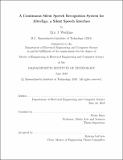A continuous silent speech recognition system for AlterEgo, a silent speech interface
Author(s)
Wadkins, Eric J.
Download1128187233-MIT.pdf (3.657Mb)
Other Contributors
Massachusetts Institute of Technology. Department of Electrical Engineering and Computer Science.
Advisor
Pattie Maes.
Terms of use
Metadata
Show full item recordAbstract
In this thesis, I present my work on a continuous silent speech recognition system for AlterEgo, a silent speech interface. By transcribing residual neurological signals sent from the brain to speech articulators during internal articulation, the system allows one to communicate without the need to speak or perform any visible movements or gestures. It is capable of transcribing continuous silent speech at a rate of over 100 words per minute. The system therefore provides a natural alternative to normal speech at a rate not far below that of conversational speech. This alternative method of communication enables those who cannot speak, such as people with speech or neurological disorders, as well as those in environments not suited for normal speech, to communicate more easily and quickly. In the same capacity, it can serve as a discreet, digital interface that augments the user with information and services without the use of an external device. I discuss herein the data processing and sequence prediction techniques used, describe the collected datasets, and evaluate various models for achieving such a continuous system, the most promising among them being a deep convolutional neural network (CNN) with connectionist temporal classification (CTC). I also share the results of various feature selection and visualization techniques, an experiment to quantify electrode contribution, and the use of a language model to boost transcription accuracy by leveraging the context provided by transcribing an entire sentence at once.
Description
This electronic version was submitted by the student author. The certified thesis is available in the Institute Archives and Special Collections. Thesis: M. Eng., Massachusetts Institute of Technology, Department of Electrical Engineering and Computer Science, 2019 Cataloged from student-submitted PDF version of thesis. Includes bibliographical references (pages 83-85).
Date issued
2019Department
Massachusetts Institute of Technology. Department of Electrical Engineering and Computer SciencePublisher
Massachusetts Institute of Technology
Keywords
Electrical Engineering and Computer Science.